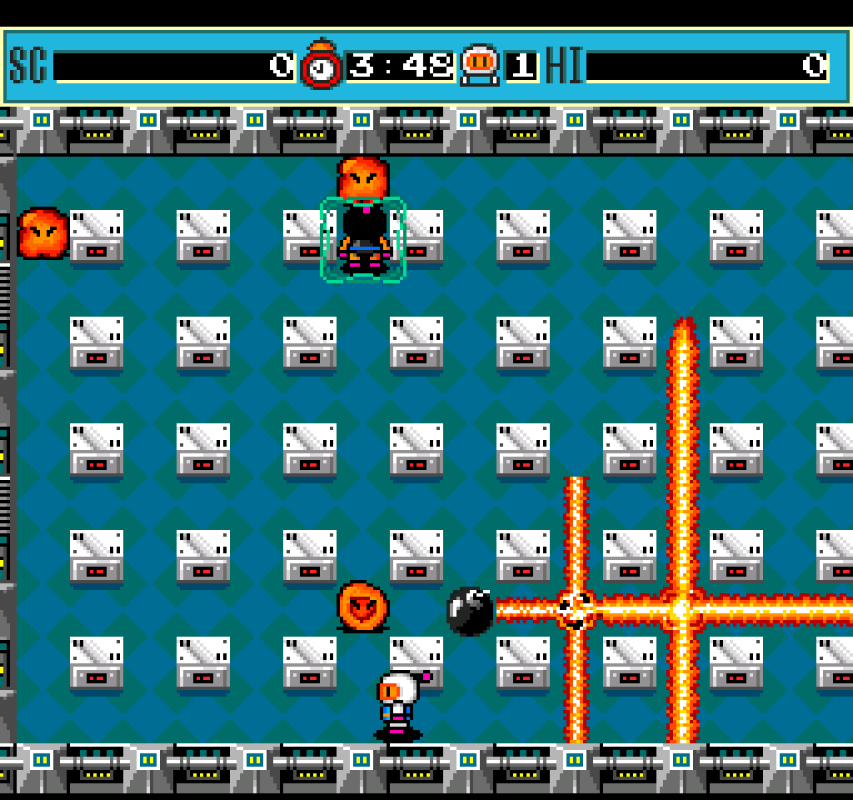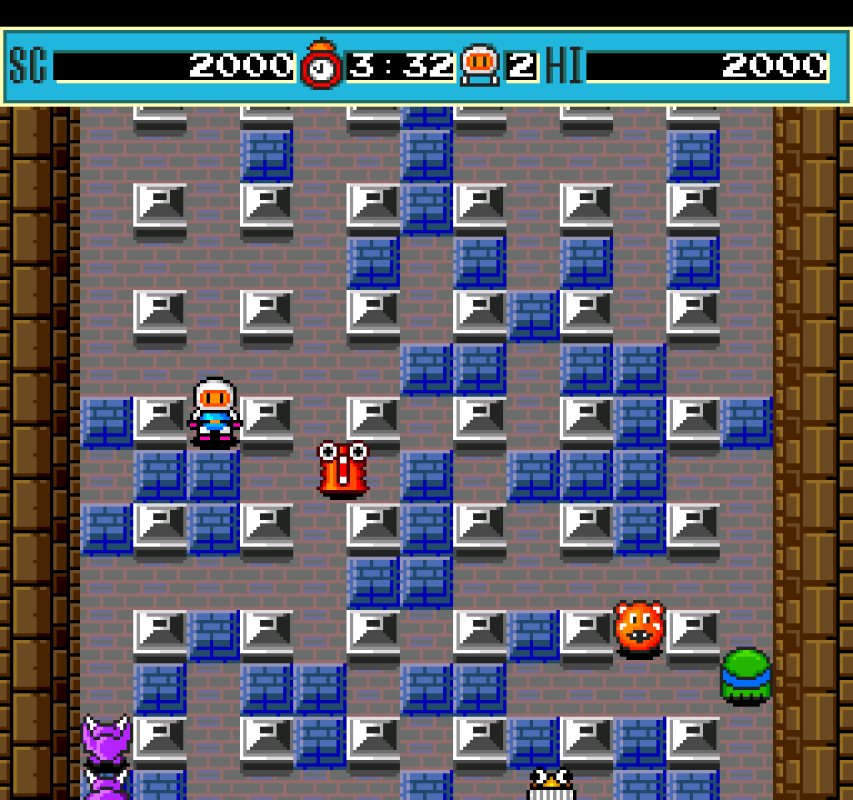Retrogaming Reviews
Latest · Alphabetical · Score · Picks · Random
Consoles
Arcade · Genesis · PS1 · PSP · SNES · TG-16
TurboGrafx-16 / PC Engine · Action-Maze · 1990
Bomberman — Who is he? What is he?
Bomberman (the game) originated on home computers in 1983, including platforms that were largely unique to Japan, such as the MSX and the PC-8801[1]. In the original lore, the eponymous Bomberman is a robot who works in an underground bomb factory, but dreams of escaping to the surface. There, according to rumours, robots can become human. With the player’s help, he must fight his way out of the factory using — what else? — bombs.
This TurboGrafx-16[2] version of the game is an enhanced remake of the original, though the story here varies somewhat. Here, the evil Black Bomberman has kidnapped Dr. Mitsumori, the creator of the peaceful White Bomberman, who must fight across the land (with bombs, natch) to save his creator.
Let’s be honest here, though — you’re not playing Bomberman for its deep lore.
A game series with a surprising amount of ports and sequels, Bomberman is — at its heart — a game about running around a maze and blowing up your opponents with cleverly-placed explosives. In fact, it’s one of those classic party games that excels at making you hate your friends — you can play this version with up to five players and delight in each others’ demise. Alternatively, you can work through the single-player campaign alone, battling against computer-controlled monsters and boss fights.
I should clarify that in this review, I’m only covering the single-player aspects of this game.
Wanton Destruction
So what’s the gameplay about? I’m glad you asked![3]
The gameplay of Bomberman is fairly straightforward and intuitive. Each stage is a walled-in arena of varying size, with a grid of indestructible blocks, and a random assortment of destructible terrain. Our ruinous robot buddy can move around the maze, laying down bombs which explode after a few seconds, killing anything that the horizontal and vertical beams of fire touch. If the fire from one bomb touches another, it triggers that bomb to also explode, which can result in a cascade of cleansing fire.
At first, you can only lay a single bomb at a time and the explosion radius is pitifully short, but various power-ups lay hidden randomly under the destructible terrain. Some of these are temporary power-ups such as immunity from fire or the ability to manually trigger bombs. Permanent upgrades allow you to lay down additional bombs, and for the trails of fire to spread further from each explosion. It doesn’t take long until you’re laying down bombs like a master, triggering deadly chains of flame.
The goal of each single-player level is to eliminate all the enemies within, then find the exit. Naturally, the exit is also hidden randomly under one of the destructible blocks, and the clock’s ticking down. Touching an enemy (or being scorched by fire) spells instant doom for Bomberman. Luckily, most of the enemies are fairly dumb and move around in a more-or-less random pattern. Foes in later levels can become more aggressive, or have the ability pass straight over the destructible blocks.
The boss battles at the end of each themed stage mix up the gameplay a bit. Larger and more dangerous, these foes take multiple hits from Bomberman’s bombs to defeat, and have their own special attacks and movement patterns.
Rough Edges
The single-player campaign is a mixed bag of difficulty. The game features continues, passwords and a save system, through which you can effectively keep playing forever. Due to the randomized nature of the level layouts, and some enemies having special abilities — particularly the ones that pass over or through obstacles — it’s entirely possible you may sometimes find yourself in an unwinnable situation before the stage has even begun.
This generally doesn’t become an issue until the last couple of themed stages. Here, orange coin-like enemies show up, who can both pass through obstacles, and aggressively path towards Bomberman. I understand the need to add extra challenge to later stages, but oftentimes, this just feels cheap and unsatisfying. Similarly, the final battle against Black Bomberman and his cronies is absolutely punishing, far in excess of any previous boss fight.
Sometimes you can just get incredibly unlucky, too. Defeated all the enemies, but the exit is underneath the very last block, and the timer’s just hit zero? Sucks to be you, champ. While the bomb capacity and flame-length upgrades are permanent, it stings to lose the borderline-overpowered upgrade that lets you trigger bombs at will (rather than being on a timer).
That’s not to say the game isn’t without its positives, of course. The gameplay is (for the most part) tight and crisp, the graphics are colourful and charming, and the soundtrack is a bouncy and fun accompaniment to the action. For a remake of the first game, it certainly does a lot of things right. It’s not deep or complex by any means, but it’s a charming romp despite its rough edges.
The Verdict

Footnotes
[1] Except in Europe, where the ZX Spectrum version of the game is titled Eric and the Floaters.
[2] Known in Japan as the PC Engine, which I think is a much cooler name.
[3] It's okay, just go along with it, don't make it weird.
Discussion
If your comment doesn't show up right away, don't worry! Sometimes they can be delayed, but it'll appear soon.











